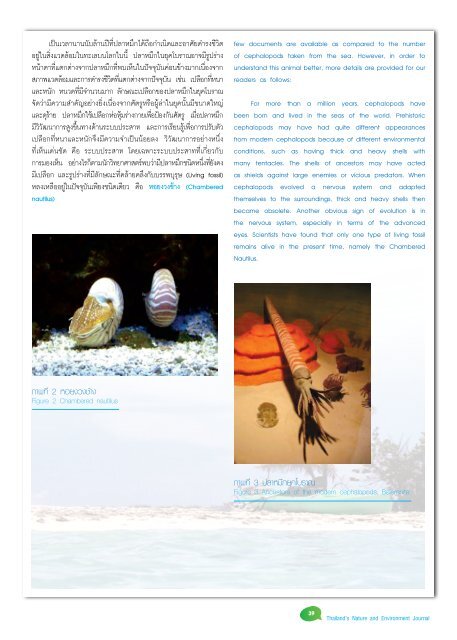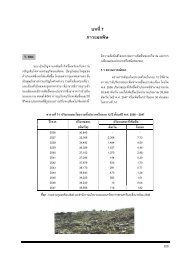ปีที่ 5 ฉบับที่ 3 กรกฎาคม-กันยายน 2552 - สำนักงานนโยบายและแผน ...
ปีที่ 5 ฉบับที่ 3 กรกฎาคม-กันยายน 2552 - สำนักงานนโยบายและแผน ...
ปีที่ 5 ฉบับที่ 3 กรกฎาคม-กันยายน 2552 - สำนักงานนโยบายและแผน ...
You also want an ePaper? Increase the reach of your titles
YUMPU automatically turns print PDFs into web optimized ePapers that Google loves.
เป็นเวลานานนับล้าน<strong>ปีที่</strong>ปลาหมึกได้ถือกําเนิดและอาศัยดํารงชีวิต<br />
อยู่ในสิ่งแวดล้อมในทะเลบนโลกใบนี้ ปลาหมึกในยุคโบราณอาจมีรูปร่าง<br />
หน้าตาที่แตกต่างจากปลาหมึกที่พบเห็นในปัจจุบันค่อนข้างมากเนื่องจาก<br />
สภาพแวดล้อมและการดํารงชีวิตที่แตกต่างจากปัจจุบัน เช่น เปลือกที่หนา<br />
และหนัก หนวดที่มีจํานวนมาก ลักษณะเปลือกของปลาหมึกในยุคโบราณ<br />
จัดว่ามีความสําคัญอย่างยิ่งเนื่องจากศัตรูหรือผู้ล่าในยุคนั้นมีขนาดใหญ่<br />
และดุร้าย ปลาหมึกใช้เปลือกห่อหุ้มร่างกายเพื่อป้องกันศัตรู เมื่อปลาหมึก<br />
มีวิวัฒนาการสูงขึ ้นทางด้านระบบประสาท และการเรียนรู ้เพื ่อการปรับตัว<br />
เปลือกที่หนาและหนักจึงมีความจําเป็นน้อยลง วิวัฒนาการอย่างหนึ่ง<br />
ที่เห็นเด่นชัด คือ ระบบประสาท โดยเฉพาะระบบประสาทที่เกี่ยวกับ<br />
การมองเห็น อย่างไรก็ตามนักวิทยาศาสตร์พบว่ามีปลาหมึกชนิดหนึ่งที่ยังคง<br />
มีเปลือก และรูปร่างที่มีลักษณะที่คล้ายคลึงกับบรรพบุรุษ (Living fossil)<br />
หลงเหลืออยู่ในปัจจุบันเพียงชนิดเดียว คือ หอยงวงช้าง (Chambered<br />
nautilus)<br />
few documents are available as compared to the number<br />
of cephalopods taken from the sea. However, in order to<br />
understand this animal better, more details are provided for our<br />
readers as follows:<br />
For more than a million years, cephalopods have<br />
been born and lived in the seas of the world. Prehistoric<br />
cephalopods may have had quite different appearances<br />
from modern cephalopods because of different environmental<br />
conditions, such as having thick and heavy shells with<br />
many tentacles. The shells of ancestors may have acted<br />
as shields against large enemies or vicious predators. When<br />
cephalopods evolved a nervous system and adapted<br />
themselves to the surroundings, thick and heavy shells then<br />
became obsolete. Another obvious sign of evolution is in<br />
the nervous system, especially in terms of the advanced<br />
eyes. Scientists have found that only one type of living fossil<br />
remains alive in the present time, namely the Chambered<br />
Nautilus.<br />
ภาพที่ 2 หอยงวงช้าง<br />
Figure 2 Chambered nautilus<br />
ภาพที่ 3 ปลาหมึกยุคโบราณ<br />
Figure 3 Ancestors of the modern cephalopods, Belemnite<br />
39<br />
Thailand’s Nature and Environment Journal

















